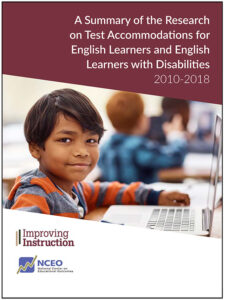 An NCEO affiliated project, the Improving Instruction for English Learners Through Accessibility Decision Making project, recently published a comprehensive literature review titled A Summary of the Research on Test Accommodations for English Learners and English Learners with Disabilities: 2010-2018. In this review, the authors examine the purpose of each study, the type of assessment measured, the content area assessed, the type of linguistic support accommodation examined, the characteristics of the research sample and the participants, the type of research design, the findings, and author-identified limitations. Some research questions addressed by this report include:
An NCEO affiliated project, the Improving Instruction for English Learners Through Accessibility Decision Making project, recently published a comprehensive literature review titled A Summary of the Research on Test Accommodations for English Learners and English Learners with Disabilities: 2010-2018. In this review, the authors examine the purpose of each study, the type of assessment measured, the content area assessed, the type of linguistic support accommodation examined, the characteristics of the research sample and the participants, the type of research design, the findings, and author-identified limitations. Some research questions addressed by this report include:
- What types of accommodations have been studied for use with English learners and English learners with disabilities?
- Do these have strong evidence for their use?
- What methodologies have been used to investigate these accommodations?
- What are continuing areas of need for research?
All eleven studies included in this analysis addressed the use of presentation accommodations that offered linguistic support. Findings on the effectiveness of accommodations studied were mixed. The literature was fairly consistent on the positive effect of translations (in Spanish) and modified English, which are some of the most frequently studied accommodations to date.
The review included studies of several newer, innovative accommodations, such as computerized delivery of pop-up English glossaries, a sticker paraphrasing tool, and the use of illustrations. The majority of the studies did not examine the effectiveness of accommodations for students with varying characteristics, with the exception of a few looking at use and effects for students with different English proficiency levels. To date, little has been published about choosing the most appropriate accommodations to suit a student’s individual learning characteristics and needs.
